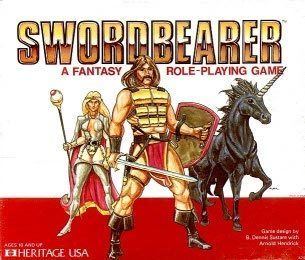 | ||
Destiny the best swordbearer in the game 2 waving crota with new update
Swordbearer is a fantasy role-playing game. It was originally published by Heritage Games in 1982, and then republished by Fantasy Games Unlimited in 1985. The game was written by B. Dennis Sustare with contributions from Arnold Hendrick. Illustrations are by Denis Loubet and David Helber. The Heritage edition cover art was by Helber; the FGU edition's cover art was by Bill Willingham.
Contents
- Destiny the best swordbearer in the game 2 waving crota with new update
- Publication history
- Innovations
- Differences between the Heritage and FGU editions
- Market appeal
- Supplements
- References
Publication history
Swordbearer was designed by B. Dennis Sustare with Arnold Hendrick, featuring art by Denis Loubet. It was first published in 1982 by Heritage USA as a digest-sized box with three digest-sized books (two 48 pages, one 32 pages), a character sheet, and dice.
Fantasy Games Unlimited (FGU) purchased the rights to Swordbearer, and also bought Heritage's old stock, something that FGU's Scott Bizar felt was a necessary part of such a deal. In 1985 FGU republished the game in the same format with new cover art by Bill Willingham; later that year, FGU published a second edition as a boxed set containing two books (one 60 pages and one 32 pages).
Contents
Swordbearer is a fantasy system with some innovative ideas. Characters have no classes or professions, instead learning whatever skills are appropriate from six different "spheres" of skills. In this moneyless system, successful characters increase in social status, automatically gaining whatever material benefits their status confers. Playing out of character can result in loss of social status. Magic is based on elemental summoning and spirit control. The "Characters" and "Fighting" book (48 pages) included character creation, skills, equipment, and combat. The "Elemental Magic" and "Spirit Magic" book (32 pages) describes the magic system in detail. The "Racial Index" and "Gamemaster's Guide" book (48 pages) covers intelligent races, monsters, and how to run the game.
Innovations
The game broke a lot of ground. Among its innovations were:
Differences between the Heritage and FGU editions
The Heritage and FGU games are almost exactly alike in terms of content. Game art, text, etc. are the same save for a larger number of typos in the FGU edition.
The physical form of the two editions is the largest difference. The Heritage edition comes in a 7x8" box, containing three rule volumes plus a character sheet. Each volume contains two books:
- Characters
- Fighting
- Elemental Magic
- Spirit Magic
- Racial Index
- Gamemasters Guide
In the FGU edition, the rules are presented in two books, with smaller sections (Introduction; Creating a Character; Skills, Experience and Activity Spheres; etc.). Books I-IV of the Heritage edition are contained in Book One of the FGU version; books V-VI of the Heritage edition make up Book Two of the FGU edition.
Market appeal
In its Heritage edition, the game did not sell well, perhaps because of its unusual packaging: a 7x8" box in landscape orientation, it looked more like a set of miniatures rules than an RPG. When republished by FGU, the game came in a more traditional letter-size form. Its lack of success under Heritage may also have been due to its innovations, or to Heritage's lack of renown as an RPG company.
Even so, under FGU the game languished. One supplement was published, but nothing further was done with the game. This may have been because of FGU's focus on Chivalry & Sorcery, its primary fantasy RPG, or because of the unusual nature of Swordbearer's rules.
Supplements
Under FGU, Swordbearer got its first supplement: Dwarven Halls, which details the dwarves and other inhabitants of a long valley. The valley is designed to be transplanted into any campaign setting—almost no mention is made of the world outside the valley—so the supplement is in some ways universal.
